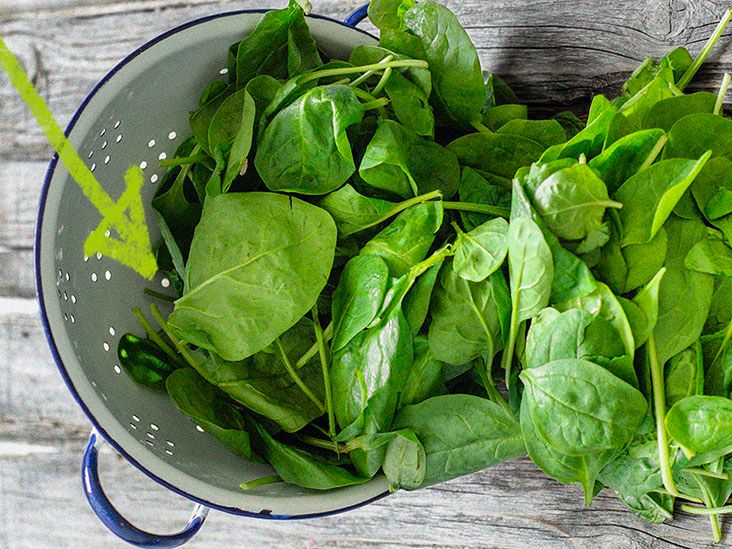6 Health Benefits of Spinach- Step By Step Guide :- Spinach, or (Spinacia oleracea), comes from central Asia and is one of the most useful leafy greens. It has enzymes and vitamins that keep you from getting chronic diseases and help keep your brain, heart, and eyes healthy.
Spinach can be eaten raw, cooked, fresh, or frozen. Spinach can be mixed into smoothies, eaten cold in a salad, steamed or sautéed as a side dish, mixed in a stir fry, or even blended into baked goods like brownies. Discover why spinach is good for you by reading on.
6 Health Benefits of Spinach

1. Helps Manage Blood Pressure
- Nitrates are chemicals that happen naturally and can be found in spinach. Because nitrates widen blood arteries, more blood flows through them and your heart is less stressed.
- In a 2016 study, seven women and eleven men drank four drinks high in nitrates, one of which was a spinach drink. The researchers discovered that the drinks raised the nitrate levels in the people who took part.
- Blood pressure went down with the green drink as well. Diastolic blood pressure, which is the number at the bottom of a blood pressure reading, tells you how much pressure is in your arteries when your heart is not beating.
- The diastolic blood pressure stayed low for five hours after drinking the spinach and rocket salad drinks, according to the experts.
2. Helps Protect Against Diseases
- Researchers have found that some chemicals in spinach may help lower reactive stress.1 When there is a mismatch between antioxidants and free radicals, which are harmful substances that hurt your cells, you have oxidative stress. There is some evidence that oxidative stress raises the chance of a number of long-term diseases, such as cancer, heart disease, and type 2 diabetes.
- Gene expression, or the “turning on” of certain genes, is also influenced positively by these substances in metabolism and inflammation. Eating more spinach might help keep you from getting long-term illnesses.

Also See :- 4 Health Benefits of Lemon- Step By Step Guide
3. Is a Source of Antioxidants
- Antioxidants in spinach help lower inflammation and keep you from getting sick. Flavonoids like kaempferol, quercetin, myricetin, and isorhamnetin are found in spinach and work as antioxidants. The chemicals in those foods help keep you from getting cancer, heart disease, and inflammatory illnesses.
4. Is Full of Nutrients
- Spinach is very healthy, but it doesn’t have many calories. Over 300% of the daily value (DV) for vitamin K is in a three-cup serving. It also has more than 160% of the daily value for vitamin A and 40% of the daily value for vitamin C.6 A and K vitamins help bones stay strong, and C helps wounds heal.
- Folate is a B vitamin that helps make red blood cells and DNA. Spinach has 45% of the daily value for folate. Spinach also has iron, magnesium, potassium, calcium, and some other B vitamins in small amounts.
5. May Support Eye Health
- Lutein is an antioxidant that can be found in spinach. It may lower the chance of age-related macular degeneration (AMD). This eye disease can make it hard to see clearly in the middle, which is important for reading and driving. AMD is the main reason why people over 55 lose their sight. Because AMD can’t be cured, it’s important to avoid getting it.
- Spinach that is high in lutein has been shown to raise macular pigment optical density (MPOD).9 This color protects your eyes like sunglasses inside your eyes. Less MPOD is a sign that you might get AMD.

Also See :- How Does Eating Protein Help You Build Muscle- Step By Step Guide
6. Might Lower the Risk of Cognitive Decline
- As a result of its anti-inflammatory properties, spinach is a leading candidate for the protection against cognitive impairment that is associated with aging. In a study that was published in 2015, researchers observed the dietary habits and cognitive capacities of over 900 adults ranging in age from 58 to 98 years old over a period of around five years.
- The cognitive capacities of those who had one to two servings of leafy green vegetables on a daily basis were comparable to those of individuals who were 7.5 years younger than them.
Nutrition of Spinach
Water makes up approximately 91% of the mass of spinach, which contributes to its low calorie content. The following nutrients are contained in a serving size of one cup of raw spinach:
- Calories: 6.9
- Fat: 0.117 grams
- Sodium: 23.7 milligrams (mg)
- Carbohydrates: 1.09 g
- Fiber: 0.66 g
- Added sugars: 0 g
- Protein: 0.858 g
Tips for Consuming Spinach
Make it a goal to consume one cup of spinach, which is roughly equivalent to the size of a tennis ball, on a daily basis. Here are some strategies to increase your consumption of spinach:
- You can mix spinach into pancakes, hummus, fruit smoothies, and more. You can also add it to soups, veggie chili, and tacos.
- Spread out a handful of spinach on top of your food before you eat it.
- Add crushed red pepper and sweet red bell pepper to extra virgin olive oil (EVOO) and cook the spinach.
- Toss the greens with olive tapenade from a jar or pesto that doesn’t have cheese after steaming them.
- EVOO, balsamic vinegar, Dijon mustard, and dried Italian herb spice should all be mixed together in a whisk to make a simple vinaigrette. Toss the spinach with this dressing.
- You can put spinach in a drink along with a healthy fat like almond butter or avocado.
If you like this Article 6 Health Benefits of Spinach Please share With your friends And family Members.
